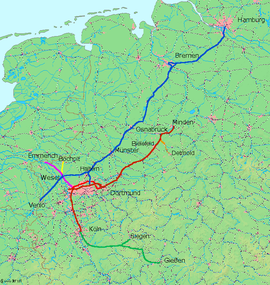Historic rail traffic Wesel
| Connection Deltaport - Wesel - connection Amprion | |||||||||||||||||||||||||||||||||||||||||||||||||||||||||||||||||||||||||||||||||||||||||||||||||||||||||||||||||||||||||||||||||||||||||||||||||
|---|---|---|---|---|---|---|---|---|---|---|---|---|---|---|---|---|---|---|---|---|---|---|---|---|---|---|---|---|---|---|---|---|---|---|---|---|---|---|---|---|---|---|---|---|---|---|---|---|---|---|---|---|---|---|---|---|---|---|---|---|---|---|---|---|---|---|---|---|---|---|---|---|---|---|---|---|---|---|---|---|---|---|---|---|---|---|---|---|---|---|---|---|---|---|---|---|---|---|---|---|---|---|---|---|---|---|---|---|---|---|---|---|---|---|---|---|---|---|---|---|---|---|---|---|---|---|---|---|---|---|---|---|---|---|---|---|---|---|---|---|---|---|---|---|---|
|
Haltern – Venlo railway line
| |||||||||||||||||||||||||||||||||||||||||||||||||||||||||||||||||||||||||||||||||||||||||||||||||||||||||||||||||||||||||||||||||||||||||||||||||
| Route number (DB) : | 2002 (Haltern – Büderich) 2003 (Büderich – border) |
||||||||||||||||||||||||||||||||||||||||||||||||||||||||||||||||||||||||||||||||||||||||||||||||||||||||||||||||||||||||||||||||||||||||||||||||
| Course book section (DB) : | ex 224b / 242e | ||||||||||||||||||||||||||||||||||||||||||||||||||||||||||||||||||||||||||||||||||||||||||||||||||||||||||||||||||||||||||||||||||||||||||||||||
| Route length: | 7.85 km | ||||||||||||||||||||||||||||||||||||||||||||||||||||||||||||||||||||||||||||||||||||||||||||||||||||||||||||||||||||||||||||||||||||||||||||||||
| Gauge : | 1435 mm ( standard gauge ) | ||||||||||||||||||||||||||||||||||||||||||||||||||||||||||||||||||||||||||||||||||||||||||||||||||||||||||||||||||||||||||||||||||||||||||||||||
| Top speed: | 15 km / h | ||||||||||||||||||||||||||||||||||||||||||||||||||||||||||||||||||||||||||||||||||||||||||||||||||||||||||||||||||||||||||||||||||||||||||||||||
|
|||||||||||||||||||||||||||||||||||||||||||||||||||||||||||||||||||||||||||||||||||||||||||||||||||||||||||||||||||||||||||||||||||||||||||||||||
The historical rail traffic Wesel e. V. is a historical museum railway with diesel locomotive operation , which runs on remnants of the Haltern – Venlo railway line and through Wesel station . On selected days there is the possibility to take the Weseler Stadt-Express over parts of the former route of the Cologne-Mindener Eisenbahn-Gesellschaft . There are five boarding options along the route.
History and present
The historical rail traffic Wesel uses the routes of the port railway Wesel, the RWE industrial railway as well as the tracks of DB Netz in the station Wesel. The former are two sections of the old Haltern – Venlo railway line. The start and end are the Rheinpromenade and Hohe Mark stops. The line was opened in 1874 and was part of the transcontinental railroad project Paris-Hamburg-Bahn.
In 1945 the Rhine bridge was blown up by the Wehrmacht . The ruins are still in parts and are under monument protection.
At the Hohe Mark stop, the locomotives can be moved using a bypass . This is the RWE handover point for heavy transformer transports , which only take place by rail. The existing sections of the route are used by the Weseler Stadt-Express, Nicholas trips and special trips. The club can also run special trips on the Deutsche Bahn network , but the club's own locomotives are not used for this.
Vehicle fleet

The historical rail traffic Wesel owns a steam locomotive Henschel of the type Hansa from the year 1916. It has 160 HP and a top speed of 30 km / h. The locomotive was last used in August 1989, the locomotive is being refurbished.
The club also owns two diesel locomotives, one of which is operational. The manufacturer is Deutz from Cologne. The club's fleet of vehicles consists of seven historic platform vehicles, four of which are operational. There is also a Jung shunting device and various freight cars .
The museum train consists of four two-axle passenger cars, so-called blunderbusses , and a two-axle Opole type freight car. Among other things, frame wagons of the Austrian Federal Railways are used.
All vehicles are parked on the company premises in the transfer station of the port railway.
Picture gallery
Web links
Individual evidence
- ↑ Railway Atlas Germany . 9th edition. Schweers + Wall, Aachen 2014, ISBN 978-3-89494-145-1 .





